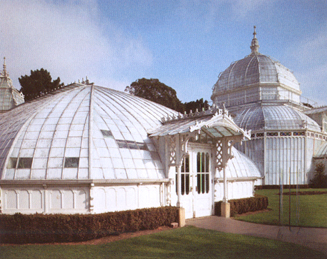
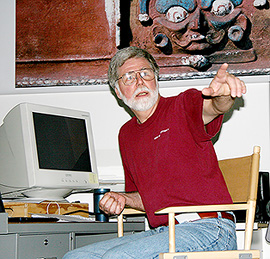
1994 R


1. Left above, first test shot taken by the Mike Collette 140MP 4x5 scanning back. The Conservatory, Golden Gate Park, San Francisco, 15 January 1994. Prototype BetterLight Scanning Camera. 6000x7520 pixels. 12-bit Trilinear Array.
2. Right above, Mike Collette, president of BetterLight Inc.
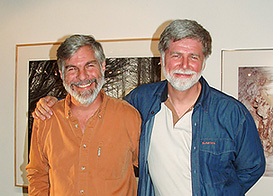
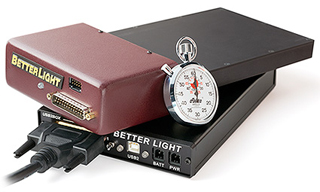
3. Mike Collette (left), with Stephen Johnson, photographer. 4. Right above, contemporary scanning back
THE DAY FILM DIED - JANUARY 15, 1994. Stephen Johnson is an internationally recognized digital photography pioneer and his photographs are in many collections and museums throughout the world. Johnson was part of the digital revolution from its earliest days, working with Leaf Systems, Foveon, Kodak, Apple, Epson, Hewlett-Packard and Adobe Systems as those companies designed and developed early model electronic and digital photography equipment and imaging programs. In January of 1994, Mike Collette, formerly of Leaf Systems, had constructed a 140 MB digital scanning back for 4x5 cameras and asked Johnson if he would like to try it. The two went to Golden Gate Park and Coit Tower in San Francisco and took photos of that same area with a film back and then with Collette's digital scanning back. Johnson described the experience thusly: "I took a loop to the film, then zoomed in on the digital file. The difference was hard to believe. That photograph completely floored me. January 15, 1994 was the last day I took film seriously as a recording medium. For me, this was the death of film; it was not a material I could stomach using ever again. From that point on, when I had the choice between film or high-end digital, I was going to pick digital without any doubt whatsoever." Stephen Johnson, On Digital Photography, O'reilly Media, Inc. Sebastopol, California, 2006, page 44.
BetterLight 4x5 scannning backs now come in sizes up to 384 megapixels. Interestingly, film supporters continued to hotly champion the superiority of film over digital well past the turn of the century, and some still do today.
http://www.betterlight.com/history.html
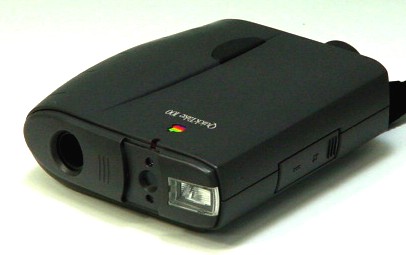

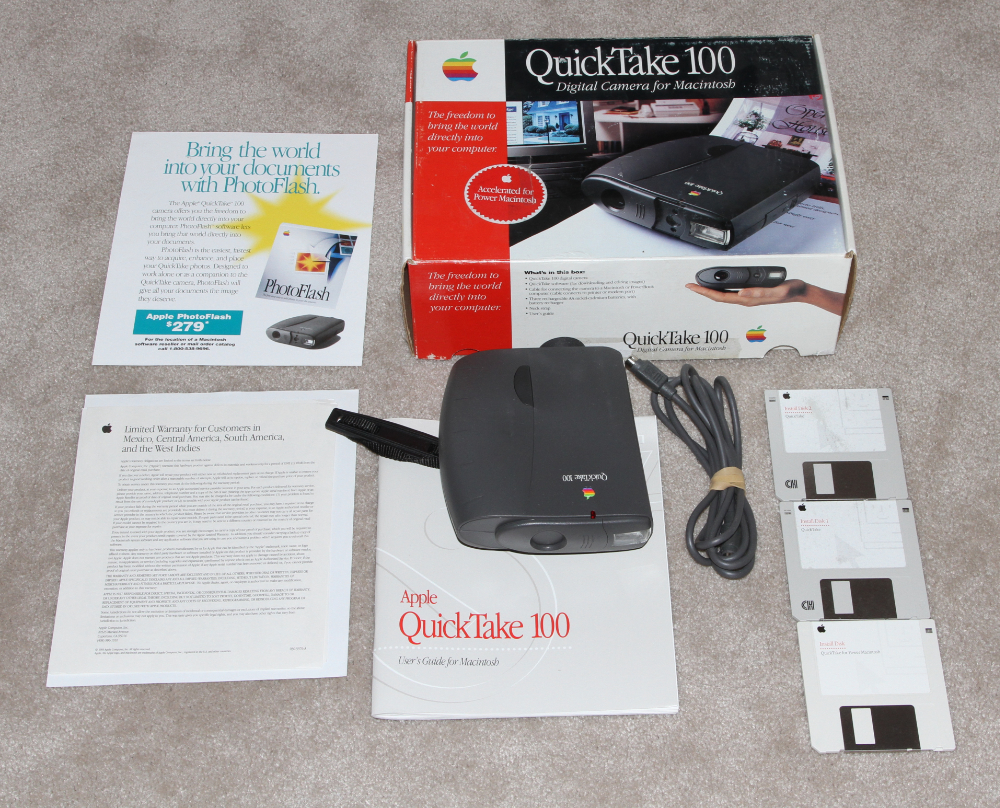
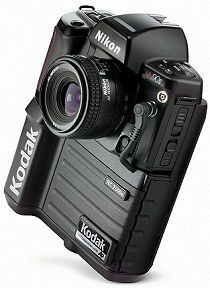

![]()
AP/KODAK
NC2000 - 1994 AND NC2000E - 1996.
First professional digital camera marketed specifically for
photojournalists. Associated Press announces marketing of digital SLR
cameras for photojournalists based on the Nikon N90 and N90s.
1024 x 1280 (1012 X 1268 usable) pixel CCD. ISO 200 -
1600. Shutter 1/8000 to 30 seconds. The Vancouver Sun
converted to all digital photography in May of 1995. The paper
became the world's first to convert from a film-based photo-production
system to an all-digital camera based photo-production system using
AP's NC 2000 camera. The staff realized that it was a tool that would
revolutionize the newspaper and wire service industry, and a tool
photojournalists had to master. Original MSRP $17,950 ($16,950
for AP members).
http://en.wikipedia.org/wiki/Kodak_DCS
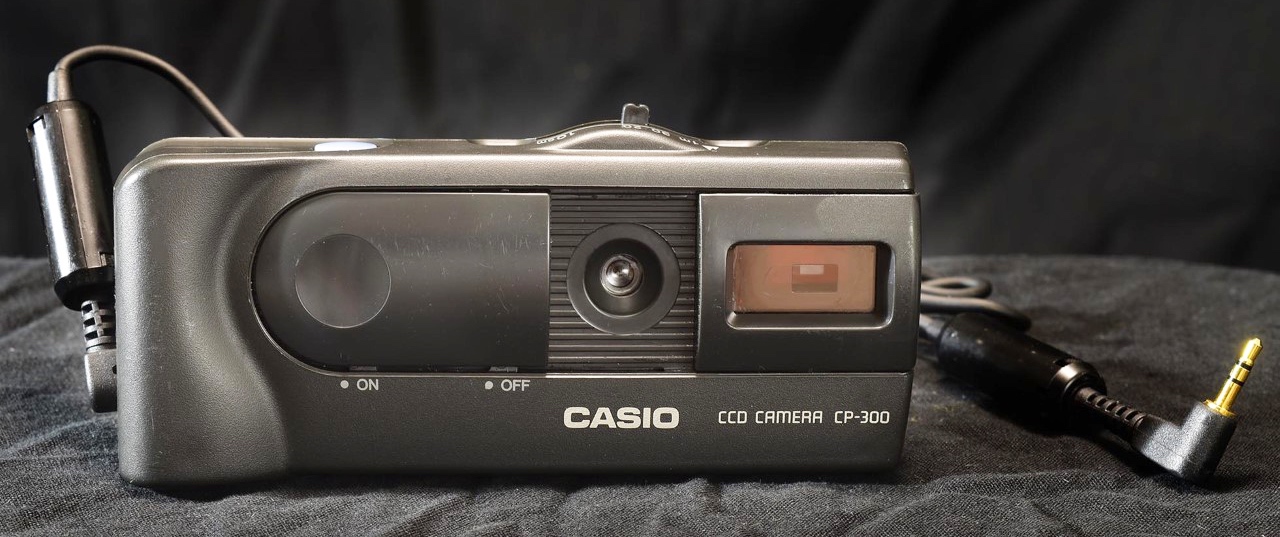
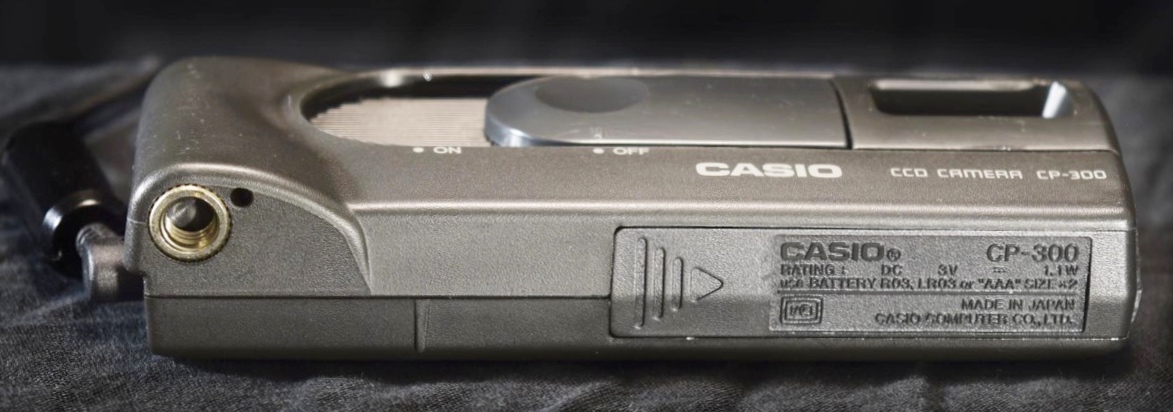
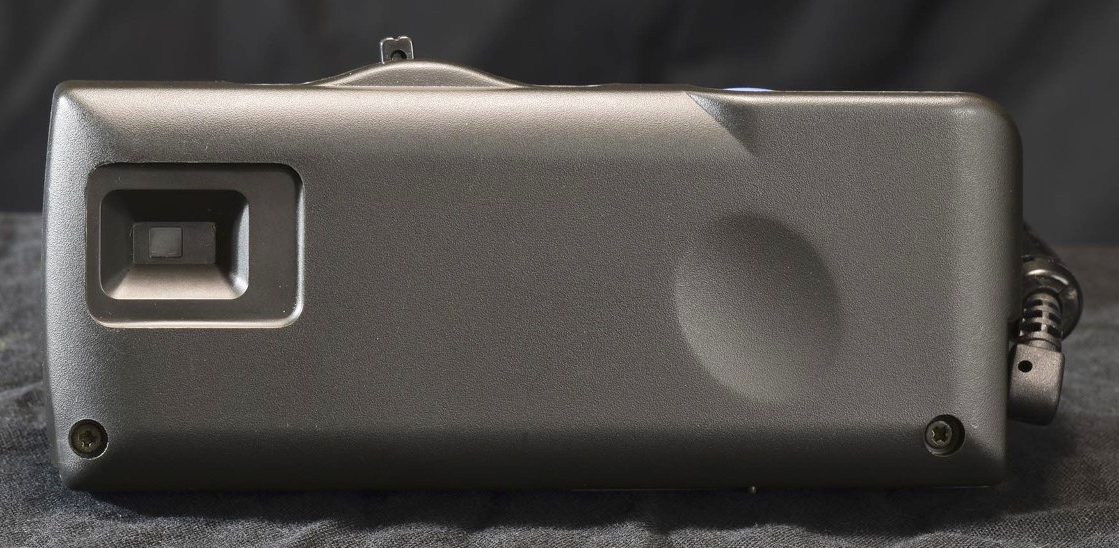

CASIO CP-300 - 1994.
These photos of a previously unknown Casio camera were submitted
by a collector in Austria. There was no other information
on the net about this camera when we received the photos.
It
was a combo model, sold
as an accessory with Casio printer products which were required in
order to produce low-quality, black & white photo prints (It's not a digital camera).
Current street value is about $10-$20.
In an
attempt to learn more about the Casio CP-300 we contacted Casio
USA. A helpful young lady there then contacted Casio of Japan on
our behalf. Casio of Japan responded quickly with the only
information they still had available concerning the CP-300 - a web site
address - our web site! Original
MSRP about $149. For more detailed information see Dennis van
Hall's site below.
https://www.digitalkameramuseum.de/en/cameras/item/casio-cp-300-ccd-camera
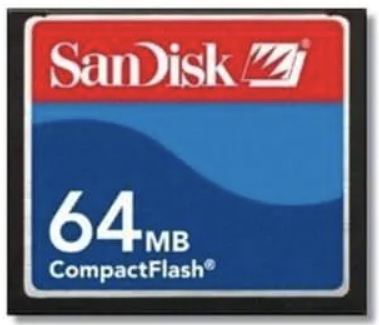

COMPACTFLASH CARD Type 1 - 1994.
CF is a mass storage media primarily used for portable electronic
devices such as digital cameras. The format was specified and the
device was first manufactured by SanDisk in 1994. The CF Type I
card is 3.3mm thick and approximately 36 x 43mm in size.
CompactFlash was originally built on Intel's NOR-based flash memory.
https://en.wikipedia.org/wiki/CompactFlash
https://www.digitalkameramuseum.de/en/memorycards
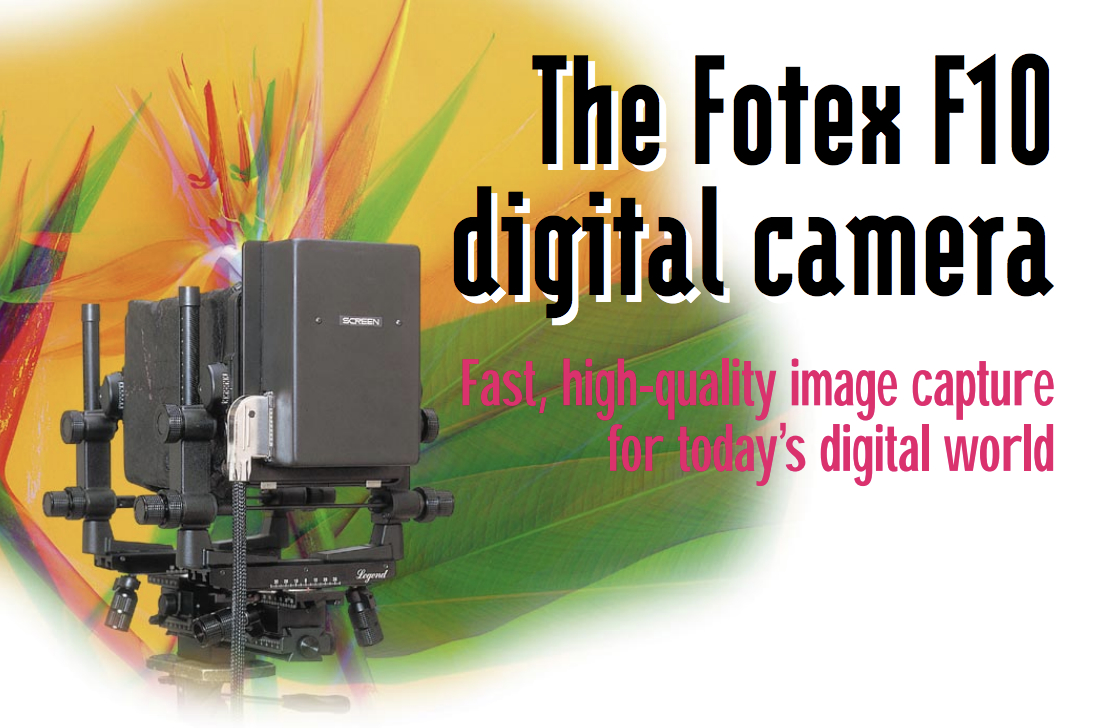
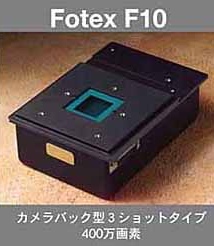
FOTEX F10 - 1994.
The Fotex F10 was a digital back with 4 X 5 camera or could also be
used as a digital camera with a Nikon or Hasselblad 35mm lens.
CCD 2048 X 2048 Pixels. It used a filter wheel and three-shot RGB
exposure system for what was very high resolution color images at that
time. Produced by Dainippon Screen of Japan.
https://www.digitalkameramuseum.de/en/cameras/item/fotex-f10
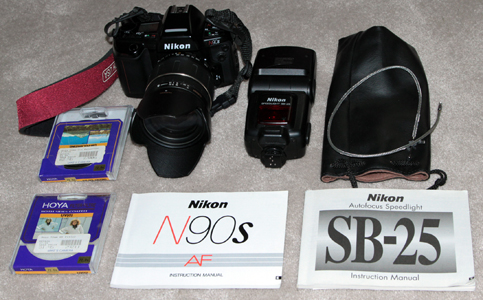
![]()
NIKON N90S (F90X) - 1994-2001. The Nikon N90s (F90x) was an autofocus 35mm film camera. It was one of Nikon's best and most expensive amateur 35mm SLRs ever. The N90s sold for over $1,000, even at discount, throughout most of the 1990s, and was sold new through 2004. The N90s was discontinued in May, 2001. The N90s replaced the almost identical N90, which was made from 1992-1994. This camera and its accessories in excellent condition were donated to the museum collection by our good friend and travel companion, Joan Klonowski of Grants, New Mexico.
http://www.kenrockwell.com/nikon/n90s.htm
http://camerapedia.wikia.com/wiki/Nikon_N90s
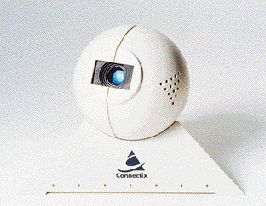
![]()
CONNECTIX QUICKCAM - 1994. An
inexpensive, black-and-white digital video camera that became one of
the best-selling Mac accessories of all time. For $99 (street price)
the buyer received a fully digital video camera which used a
charge-coupled device (CCD) array to capture grayscale video and still
images up to 320 x 240 pixels. Because the camera worked with a
PowerBook or a notebook PC, it was possible to capture digital images
and video virtually anywhere. QuickCam's small size and weight, along
with its positioning flexibility (it could be tripod-mounted, used on
its supplied stand or hand-held) made it a favorite.
http://en.wikipedia.org/wiki/QuickCam
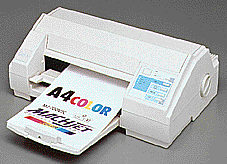
 EPSON DESKTOP COLOR INKJET PRINTER, MJ-700V2C - 1994. The first 'photo quality' desktop inkjet printer. At 720
by 720 dots per inch, it offered double the resolution of other color printers
of the time.
EPSON DESKTOP COLOR INKJET PRINTER, MJ-700V2C - 1994. The first 'photo quality' desktop inkjet printer. At 720
by 720 dots per inch, it offered double the resolution of other color printers
of the time.
http://global.epson.com/company/corporate_history/
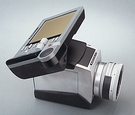
HASSELBLAD
DIGITAL CAMERA DESIGN - 1994.
UMEA
University
Institute of Design in Collaboration with Hasselblad Electronic
Photography.
Degree Project by Stina Nilimaa who graduated in 1995. NOT MARKETED.
https://lusid.se/wp-content/uploads/2019/09/YB_2001-2006_JUST_FIVE_YEARS.pdf
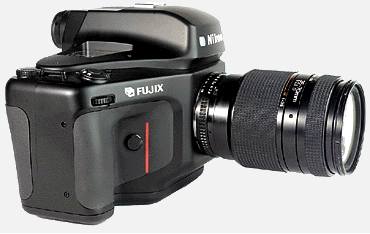

FUJI
DS-505, DS-515 (Nikon E2, E2S - see below) - 1994. Considered to be the first full-frame (no crop factor - 36 X 24mm) digicam. The
Fuji DS-505/DS-515 and Nikon E2/E2s (see below) digital cameras were PC
card
(ATA) equipped SLRs that were compatible with a wide range of
interchangeable
Nikon lenses and accessories. 2/3-inch, 1280 x 1000 pixel
CCD.
ISO 800, 1600. Shutter 1/8 to 1/2000 second. Digital
Photography,
David Busch, 1995, p51. (Extremely Rare on U.S. eBay).
https://www.digitalkameramuseum.de/en/cameras/item/fujix-ds-515
https://www.digitalkameramuseum.de/en/cameras/item/fujix-ds-505
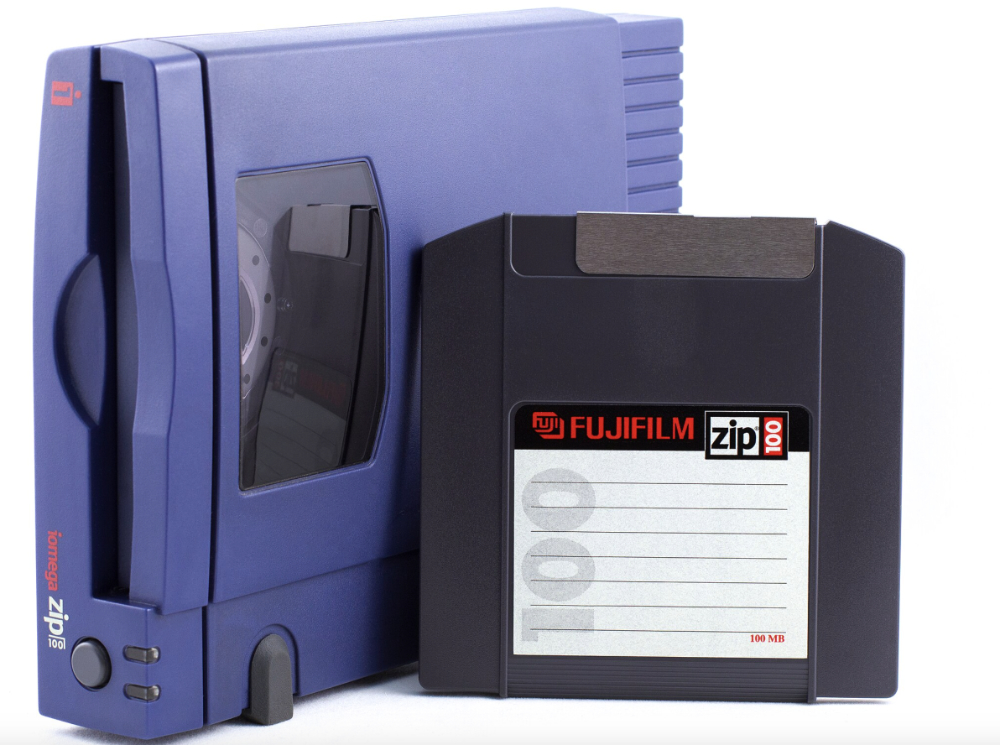

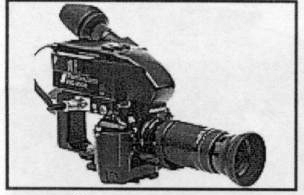
THE FOCAL POINT PENTACAM VSC/3000 Hydra Camera - 1994. A company called The Focal Point introduced this unusual still video camera in 1994. It consisted of a Sony video camera combined with a Nikon F4S 35mm SLR film camera. It could take still or video images, but required a videotape recorder, frame grabber, computer, and of course a lens, none of which were included in the $23,000 price. 768 x 494 three-chip CCD.
https://prezi.com/hrb6flrpcu6f/history-of-the-camcorder-timeline/
https://www.digitalkameramuseum.de/en/prototypes-rarities/item/pentacam-vsc3000
https://www.wired.com/1995/08/fetish-81/
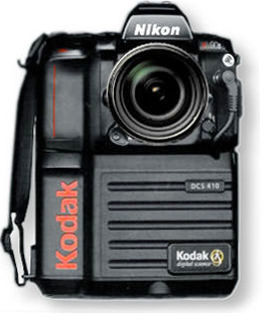
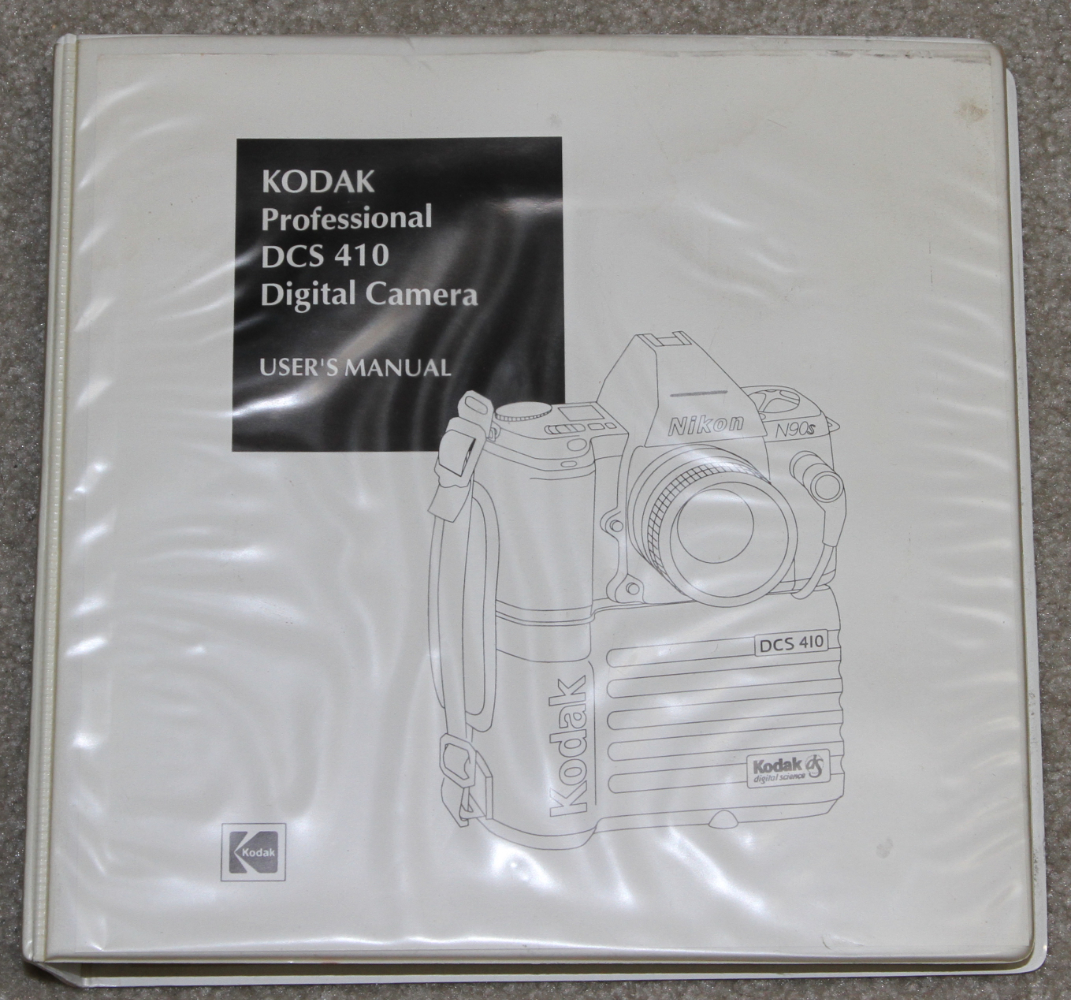
![]()
KODAK
DCS-410 - 1994.
Based on Nikon F90 body (some models may have used N90 or 90s body).
1012 x 1524 pixel CCD. ISO 100. Could accommodate most
Nikon
lenses and accessories. It used the same Kodak 1.5-million-pixel
CCD as the $11,000 DCS 420 (1994), which had a resolution of 1524 x1012
pixels. It was the only midrange filmless camera that featured a
color depth of 36 bits. MSRP $7995.
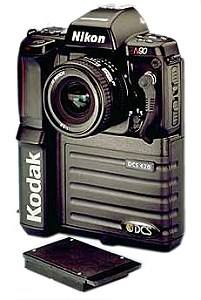
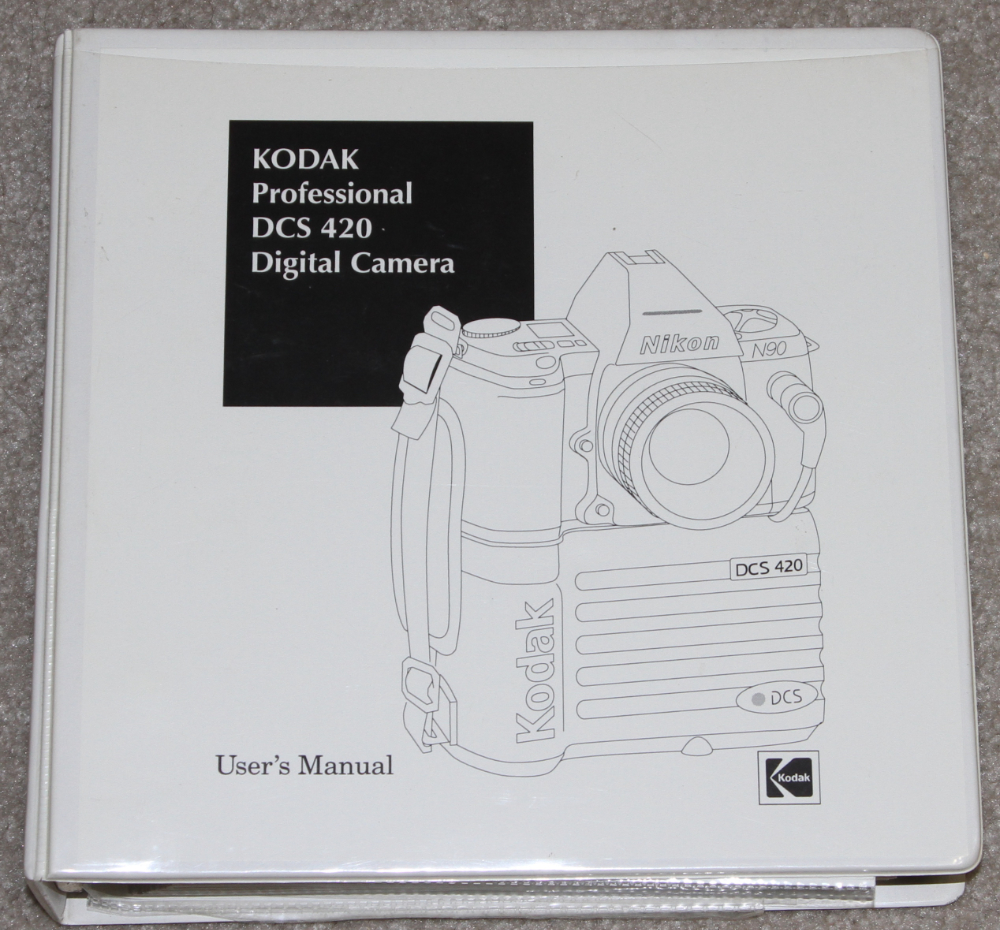
![]()
KODAK
DCS 420, DCS 420c, DCS 420m, DCS 420cir - 1994. Based
on Nikon N90X. 1524 x 1012 pixel images. Image
storage
on removable PC cards, Type III 12 bits/color. 14 mm x 9.3 imager
magnified focal length of the lens 2.5X. SCSI interface.
ISO-equivalent
settings of 100 to 400 for color model, 200 to 800 for monochrome
model.
Burst rate of 2 images/second for 5 images, enabling 5 images in just
over
2 seconds from camera to capture. MSRP $11,000. (The 420 cir infrared version came out in 1996.)
http://apphotnum.free.fr/N2BE10.html
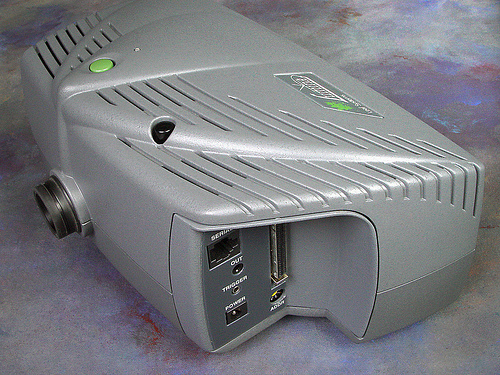
LEAF LUMINA / LEAF LUMINA MEDICAL - 1994. The
Leaf Lumina by Leaf Systems Incorporated was a digital SCSI scanner
camera used with a 35 mm Bayonet F-Mount Nikon lens. As a
scanning camera, it was used for studio still image photography.
MSRP $4995 ($31,000 in 2009 dollars).
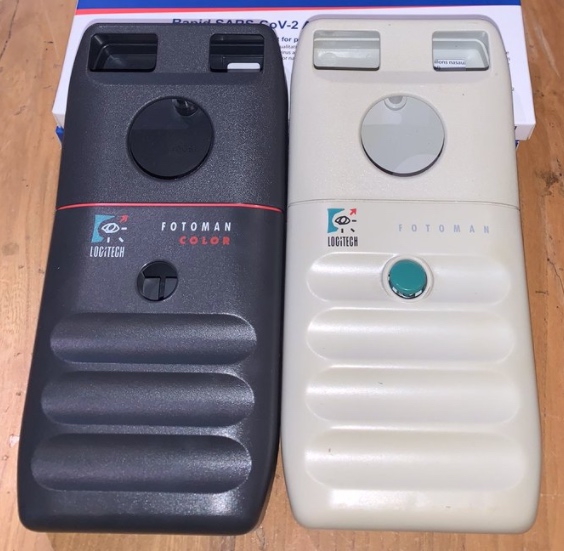
LOGITECH FOTOMAN COLOR -1994.
Logotech developed a color version of their Fotman camera. 495 x
366 pixel color CCD. Lens F4.5. Shutter 1/20 second to
1/2000 Second. NOT MARKETED.
https://www.digitalkameramuseum.de/en/prototypes-rarities/category/logitech-3
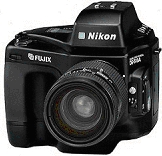

![]()
NIKON
E2, E2S (Fuji DS-505, DS-515) - 1994. See Fuji DS-505 and DS-515 above. "First
digital SLR's to not have a 'crop factor' and are still the only
35mm-family ones to do it with a smaller than fullframe sensor." Andrew
K. Bressen.
http://www.mir.com.my/rb/photography/companies/nikon/htmls/models/digitalSLRs/E2NE2Ns/
https://www.digitalkameramuseum.de/en/cameras/category/nikon-2
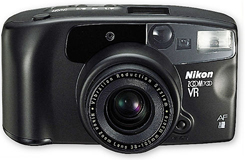

![]()
NIKON ZOOM 700 VR QD - 1994. The first 35mm camera with an image stabilization feature (vibration reduction) was the Nikon Zoom 700VR QD 35mm film compact camera released in 1994. It used two types of sensors in its lenses to detect movement to identify the direction and scale of shaking at the time of exposure. The result was used to drive a compensatory optical system using a linear motor to reduce the movement of the image in real time.
http://camera-wiki.org/wiki/Nikon_Zoom_700_VR/Zoom-Touch_105_VR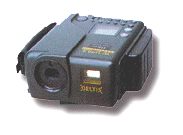

OLYMPUS
DELTIS VC-1100 - 1994. The
VC-1100
was
the world's first digital camera with built-in transmission
capabilities.
Photojournalists and other photographers could connect a modem to the
VC-1100
and upload digital photos over cellular and analog phone
lines.
The camera, which had a built-in zoom lens and an image-capture
resolution
of 768 by 576 pixels, stored images on PCMCIA cards. Its color
LCD
viewfinder let you preview photos on location. Shutter 1/8 to
1/1000
second. Lens 54mm and 108mm. The VC-1100's
transmitter
enabled pictures to be sent over phone lines or a cellular network to a
second camera or personal computer. The Deltis transmitted at the
rate of one frame every one to six minutes, depending on the picture
quality
required. The 21-ounce camera, a battery pack, and memory card
cost
about $4000. The VC-1000 did not have transmission capability and
was around $300 cheaper.
https://www.digitalkameramuseum.de/en/cameras/item/olympus-deltis-vc-1100
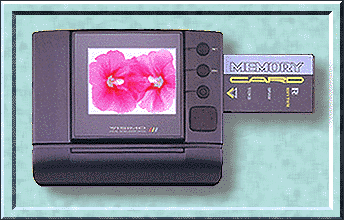

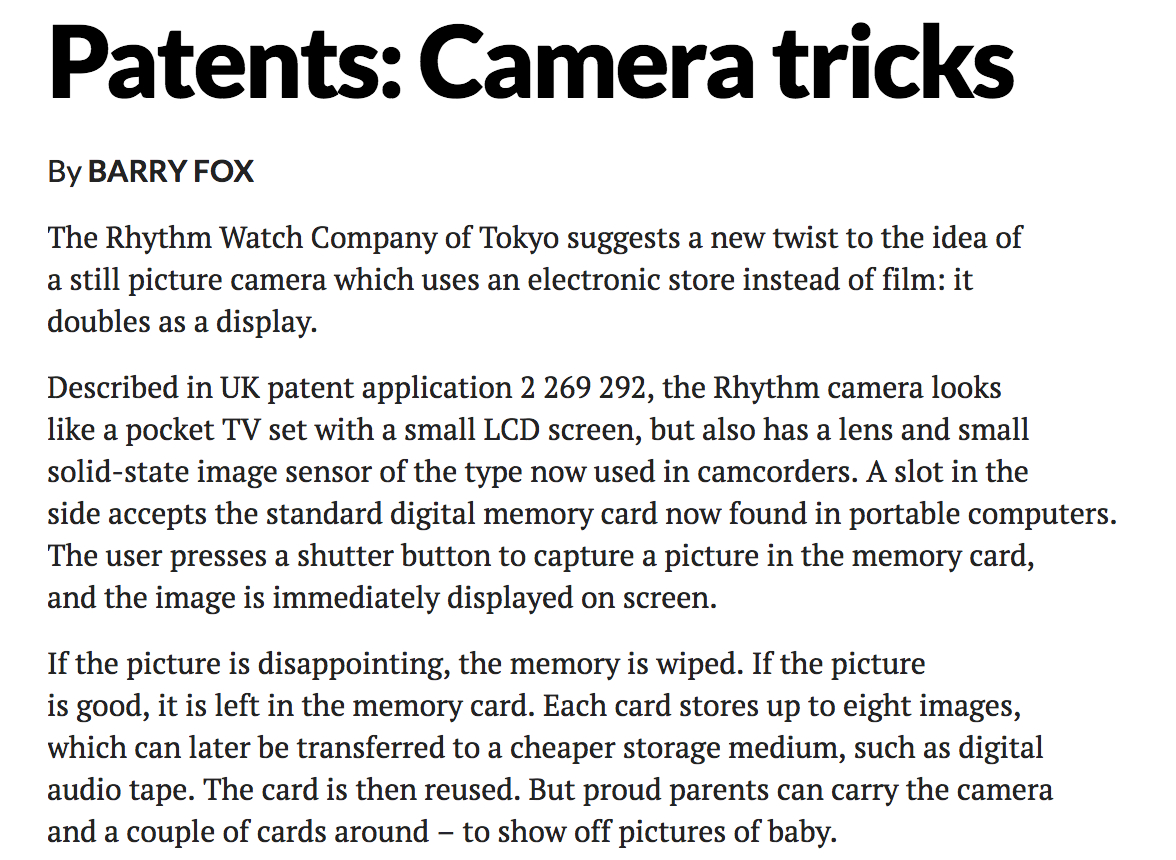
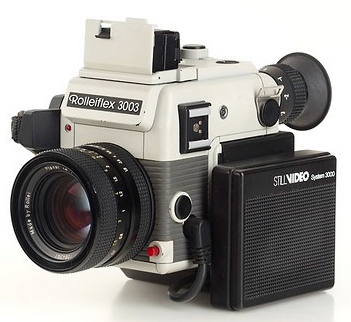
ROLLEIFLEX 3003 STILL VIDEO PROTOTYPE - 1994.
The 3003 still video prototype was based on the Rolleiflex 3003 35mm
SLR film camera, possibly only one or two made. NOT MARKETED.
http://collectiblend.com/Cameras/Rollei/Rolleiflex-3003-(still-video-prototype).html
ROLLEIFLEX SL 2000F STILL VIDEO PROTOTYPE - 1994. The SL 2000F still video prototype was supposedly based on the Rolleiflex SL 2000F 35mm SLR film camera, apparently only one made and kept for a while in the Rollei museum, then sold for a very high price. Questions have since been raised as to whether it really was a still video type or not. A still video camera at that time would have recorded onto a small mini floppy disk. From the one view above it is not possible to tell whether provision was made for inserting the required floppy. One site on eBay is currently asking $9,995 for this camera (March 2019). If it is not a still video prototype as one site claims (second URL below), there could be a problem. NOT MARKETED.http://collectiblend.com/Cameras/Rollei/Rolleiflex-SL-2000-F-(still-video,-prototype).html
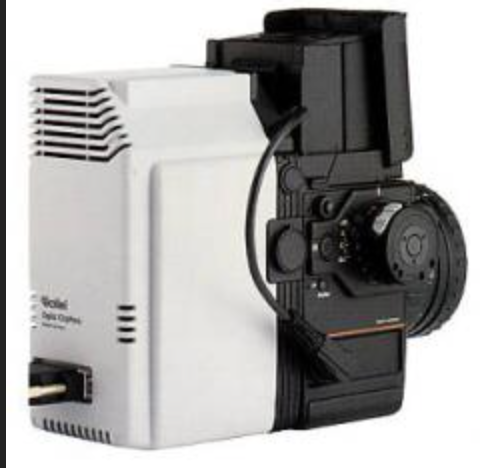
Rollei Digital Chip Pack - 1994.
Rollei marketed a Digital Chip Pack followup of the 1990
ScanBack. It took 30 secs to take a color photo at 2048x 2048
pixels.
https://vk.com/wall-90182339?offset=60
http://camera-wiki.org/wiki/Rollei
https://www.digitalkameramuseum.de/en/cameras/item/rollei-digital-chippack
SONY MAVICA MVC-5000 ARMY - 1994.
During the Gulf War the U.S. Army used a modified Sony MVC-5000 to send
digital images to elsewhere. It used a 400mm, 60 to 300mm
zoom lens. The camera images could be manipulated and time/date
stamped. The system was referred to as the CP-2098A/U Digital
Imaging Set. The set included a Harris Image processor and
several other pieces of equipment. See URL below for additional
photos and further information. Also see our 1989 page for use of
a similar system during the uprising in Tianamen Square, China. NOT ON CONSUMER MARKET.
http://www.prc68.com/I/PSC6.shtml
https://www.digitalkameramuseum.de/en/prototypes-rarities/item/sony-mvc-5000-us-army
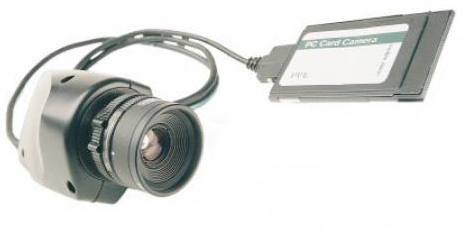

VLSI PC CARD CAMERA - 1994. The
first ever PC card camera was marketed by VLSI Vision of Edinburgh,
England. Black and white pictures with 320 X 240 pixels, 256 grayscale.
MSRP $599.
http://www.telecompaper.com/news/pc-card-camera-offered-by-vvl--37690
qHhDPyUa0J&sig=ACfU3U2134WfqLSu_mJQAgUnGVS8hDBvZQ&hl=en&sa=X&ved=
2ahUKEwiRucPolovoAhUIHjQIHcqaB9kQ6AEwAHoECAcQAQ#v=onepage&q=VLSI%20PC%20CARD%20CAMERA&f=false
1994